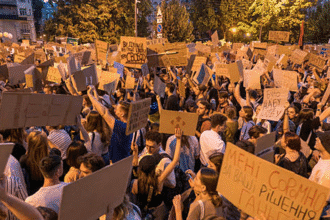In a significant shift in US military policy, President Joe Biden has authorized the use of long-range missiles supplied by Washington, including the Army Tactical Missile System (ATACMS), to strike deep inside Russian territory. This decision marks a significant escalation in the support provided to Ukraine as it seeks to defend its sovereignty against Russia’s invasion.
- What Does This Shift in US Policy Mean for Ukraine?
- How Will ATACMS Missiles Enhance Ukraine's Defense?
- What Are the Risks of Escalation and Russia's Response?
- How Will ATACMS Help Ukraine Respond to Russian Advances?
- What Challenges Does Ukraine Face in Using ATACMS Missiles?
- How Could NATO's Involvement and Support Change as a Result?
- What are the political implications for US support for Ukraine?
Until now, the US had resisted allowing Ukraine to use these weapons on Russian soil, fearing that such strikes could lead to a broader confrontation. However, with tensions rising and a growing sense of urgency, this policy reversal may be a calculated attempt to strengthen Ukraine’s position in an increasingly precarious conflict. The move comes just months before Biden hands over power to Donald Trump, whose stance on Ukraine has raised concerns about the future of American support.
What Does This Shift in US Policy Mean for Ukraine?
For over a year, Ukraine has used ATACMS missiles on Russian targets within occupied Ukrainian territories. The long-range capabilities of these missiles, which can strike targets up to 300 kilometers (186 miles) away, make them a critical tool for Ukraine’s military strategy. However, the US has never allowed these missiles to be fired inside Russia—until now.
“Strikes are not made with words… The missiles will speak for themselves,” said Ukrainian President Volodymyr Zelensky, emphasizing the significance of the weapons in the ongoing war.
The decision to permit such strikes inside Russia is primarily seen as a response to several factors, including the recent involvement of North Korean troops supporting Russian operations in the Kursk region and fears that US support for Ukraine might wane if Donald Trump wins the upcoming presidential election.
How Will ATACMS Missiles Enhance Ukraine's Defense?
ATACMS missiles, manufactured by Lockheed Martin, are launched from either the M270 Multiple Launch Rocket System (MLRS) or the M142 High Mobility Artillery Rocket System (HIMARS). Each missile costs around $1.5 million and comes in two configurations: one with a cluster warhead designed to destroy lighter-armored units, such as aircraft, air defenses, and concentrations of troops, and the other with a single 225 kg high-explosive warhead, which is used to destroy larger, hardened structures.
The missiles follow a ballistic path, making them difficult to intercept, and their range and precision provide Ukraine with an opportunity to strike critical Russian military infrastructure deep within its territory.
“The ATACMS missiles will allow us to strike Russian military bases, infrastructure, and ammunition storage deep within Russian-held territory,” said a senior Ukrainian military official. “This is a game changer for our defense strategy.”
What Are the Risks of Escalation and Russia's Response?
The move to allow ATACMS strikes inside Russia could risk further escalating the war. Russian President Vladimir Putin has consistently warned against the use of Western weapons inside Russia, viewing it as direct NATO involvement in the conflict.
“It would substantially change the very essence, the nature of the conflict,” Putin warned in September. “This will mean that NATO countries, the USA, and European states are fighting with Russia.”
While some observers fear that this decision could provoke a broader confrontation, others argue it was necessary to ensure Ukraine’s ability to defend itself against an increasingly aggressive Russian offensive.
How Will ATACMS Help Ukraine Respond to Russian Advances?
Ukraine’s decision to deploy ATACMS missiles inside Russia is expected to focus initially on the Kursk region, where Ukrainian forces hold significant territory. The presence of North Korean troops in the area has raised alarms in Kyiv, with Ukrainian and US officials anticipating a counter-offensive aimed at retaking lost ground.
With Russian military jets now stationed further inside Russia in anticipation of this policy change, Ukrainian officials hope that the long-range missile strikes will disrupt Russian operations by targeting supply lines, military installations, and airbases.
“The ability to hit key Russian positions in Kursk and other regions will stretch Russian supply lines and complicate their ability to maintain control over occupied territories,” said a senior US defense official. “This is about giving Ukraine a fighting chance to defend itself.”
What Challenges Does Ukraine Face in Using ATACMS Missiles?
While the move is seen as a significant step forward in Ukraine’s military capabilities, there are concerns about the limited number of ATACMS missiles available for deployment. The Pentagon has reportedly warned that the US has a limited stock of these advanced weapons, raising questions about how long they can sustain such an effort.
“The question is, how many missiles do they have? We’ve heard that the Pentagon doesn’t have that many ATACMS missiles available for Ukraine,” said Evelyn Farkas, a former deputy assistant secretary of defense during the Obama administration. “That being said, the psychological impact of these strikes cannot be underestimated. It could significantly raise morale in Ukraine and destabilize Russian morale.”
One of the critical targets for these missiles could be the Kerch Bridge, which links Crimea to mainland Russia. Strikes on this strategic infrastructure would send a powerful message about Ukraine’s ability to retaliate against Russian operations inside its borders.
How Could NATO's Involvement and Support Change as a Result?
The decision to allow ATACMS strikes inside Russia could have far-reaching consequences not just for Ukraine but for the broader geopolitical landscape. The shift in policy may open the door for other NATO allies, such as the UK and France, to authorize their long-range missiles, like the Storm Shadow, to be used against Russian targets.
“The decision to permit Ukraine to strike deep within Russia could lead to other countries providing similar weapons,” said a NATO source. “If other NATO members follow suit, it could put further pressure on Russia and demonstrate NATO’s unwavering commitment to Ukraine’s defense.”
As tensions continue to rise, the Biden administration faces increased pressure to ensure that Ukraine is well-equipped to defend itself against Russian aggression. The policy shift regarding ATACMS is part of a broader strategy to bolster Ukraine’s military capabilities, but its impact on the war’s trajectory remains uncertain.
What are the political implications for US support for Ukraine?
As President Biden’s term nears its end, many in Ukraine worry about the future of US military aid. Donald Trump’s upcoming return to the White House has raised concerns about the continuity of American support for Ukraine. Trump has made it clear that he intends to bring the war to an end quickly, but the specifics of how he plans to achieve that remain unclear.
“We are worried. We hope that [Trump] will not reverse [the decision],” said Oleksiy Goncharenko, a Ukrainian Member of Parliament. “This is a crucial moment for Ukraine, and we need continued support.”
Some of Trump’s allies, including Vice President-elect JD Vance, have suggested that the US should stop providing military aid to Ukraine. Still, others, like National Security Adviser Michael Waltz, believe that accelerating weapons deliveries could force Russia to negotiate.
“The US must continue to support Ukraine, and if that means providing more weapons, so be it,” Waltz argued. “Russia will not back down unless they face serious consequences.”
With the future of US military aid hanging in the balance, the next few months could prove decisive for Ukraine’s ability to maintain its defense against Russia. As the war drags on, the international community will closely monitor how US domestic politics and the shifting battlefield dynamics affect the outcome of the conflict.








